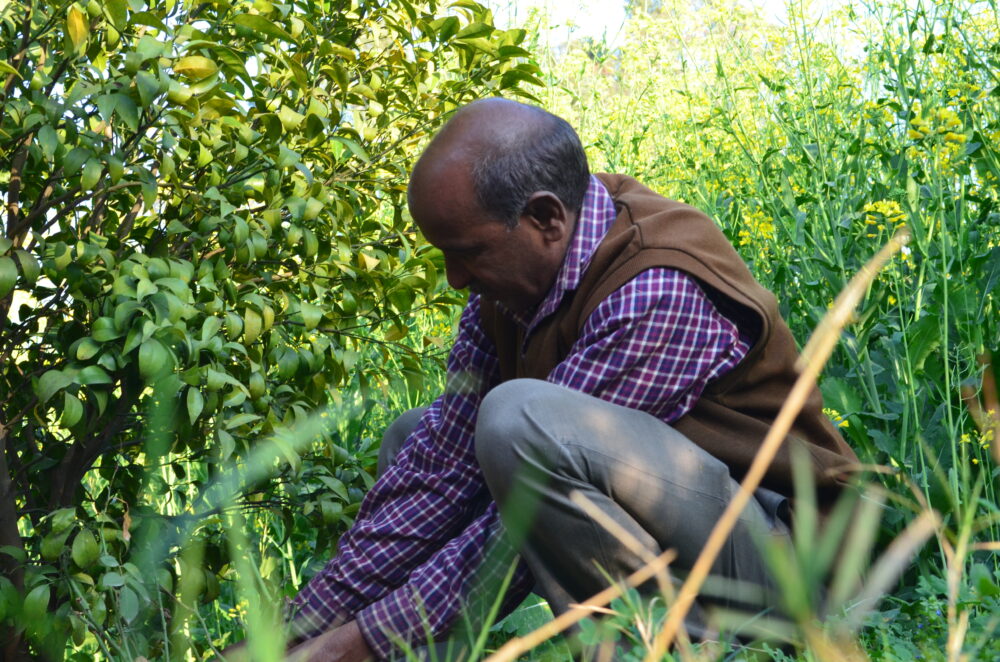The sun of spring gleams on a fine Saturday morning. An old man dressed in humble clothing cycles down the driveway. He dismounts from his black bicycle with a frayed seat-cover. He proceeds towards a pit that he dug up a couple of weeks ago. Extending his hand, he checks whether the soil is ready for plantation. An expression of delight takes over his face. From his bicycle’s rusty carrier, he picks up a young Gulmohar (Royal Poinciana) and sets it in the soil. As he waters the plant, droplets coruscate from the leaves. This 57-year-old man can now claim with pride that he’s planted over 100 trees in the city of Chandigarh, India.
Bidhi Singh Chaudhary, born in the Kangra district of Himachal Pradesh, India, recalls when he planted his first tree as a pre-teen in Chandigarh. Today, he has lost count of how many plants, shrubs, seasonal flowers, crops, and vines he has sown. He remains confident, though, that the number of trees he’s planted are in the three-digits. It’s especially significant in today’s eco-conscious age. Here is a man who has been supporting the eco-friendly movement for years, without the pomp of media coverage. His story becomes even more interesting when one realises that Chandigarh is a city. A modern planned city in fact, designed by Le Corbusier. Planting trees in a forest or a village is relatively straightforward. When it comes to a planned urban city that serves as the capital of two states, however, it is an entirely different scenario.
Bidhi claims, correctly, that all one can see in Chandigarh is green. All concrete and brick buildings are shrouded by trees. He has contributed to this skyline by planting his favourite trees like Mango, Neem (Azadirachta Indica), and Gulmohar (Royal Poinciana) all around the city.
It’s said, ‘where there’s a will, there’s a way.’ As Bidhi walks into the garden to weed the grass surrounding a nearby mango tree, he recalls a memory exemplifying the saying. After the turn of the millennium, on a hot summer afternoon, an officer was chewing a mango while attempting to beat the heat. After he was finished, he threw away the seed which became stuck in a water pipe. Coming across it later that day, Bidhi, out of a sense of public duty, removed the seed. Instead of throwing the seed away, he planted it. Today, it has become a full-grown healthy tree. This is in part due to the fertile soil of Chandigarh, a part of Punjab where the locals jokingly say that even a buried corpse would sprout in this land.
It’s also said that one who plants a tree while knowing he may not sit under its shade has understood the true meaning of life.
It’s also said that one who plants a tree while knowing he may not sit under its shade has understood the true meaning of life. Though Bidhi has already planted many trees around the city, he has been fortunate enough to see each one of them grow. He says that today people remember him for his tree plantation. One tea seller in Sector 22, who puts up his stall under a mango tree which Bidhi planted, calls Bidhi by his nickname: ‘Aamb Da Malik’ (“The Tree Planter”).

Tree planting is often driven by the planter’s personal enthusiasm. Such behaviour along with religious myths about certain trees like Peepul (Sacred Fig) can lead to short-sighted planting. For example, planting trees near constructed areas like roads, houses, shops, and other buildings can cause problems as they grow.
“The issue is that these trees can knock down buildings, since their roots can spread dozens of meters. Thus, I suggest paying attention to the location of plantation in order to seed suitable trees. This way, they don’t have to be cut down after a couple of years”, Bidhi said.
It may not always be that big of an issue if such trees are planted before construction. For example, one can opt for taproots and other trees which don’t grow large roots. Fruit trees like Mango, Guava, Mulberry, Mandarin Hybrid, and Lime are suitable in this regard. Flowering trees like Kusum (Schleichera), Moulmein Rosewood, Amaltas (Cassia Fistula), Palash (Sacred Tree), and Jacaranda seize their viewers’ eyes with their flamboyance. On the other hand, Silver Oak, Palm, and Ashoka are best for narrow laneways and alleys.
Bidhi believes that people often plant the wrong kind of tree in the wrong place. This results in arduous maintenance later down the track. Hence, he suggests planning before planting. Potential seeders should make sure to do a bit of research about what kind of tree they intend to use to decorate the garden or driveway.
Perhaps, their work is rewarded by nature itself. Uncredited milestones remain the foundation of their art.
Gardeners are the artists of nature. They may mostly draw upon their urban canvas in green, but their work has in fact a multiplicity of colours and shades. It delights the senses, bolstered by fragrances. Like painters, gardeners often use water but their brushes are rakes and trowels. They make music with the help of their fellow freelance artists, the birds. Now, their motion graphics are a bit slow at first glance — yet, over time, they graciously animate sprouting leaves, flowers, branches, and fruit. The sun takes care of the lighting, and fireflies contribute at night. Perhaps, their work is rewarded by nature itself. Uncredited milestones remain the foundation of their art.
There are many gardeners like Bidhi, who mediate nature and mankind. They remain underappreciated for their service to both. A gardener’s canvas is the garden itself — it affects our subconscious state of living. It is a blessing for us all that they do it out of their love for the nature, and not for credit or validation from humans. Their aim of planting trees is not motivated by the fact that its wood will be useful in years to come. Rather, that its fruit, shade, and oxygen help the environment light up in merriment.
Perhaps, the next time we cherish a small patch of greenery we should remind ourselves of its artist. It is a work that may not carry a signature, but the birds, ladybugs, and butterflies appreciate it all the same.





